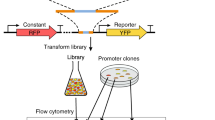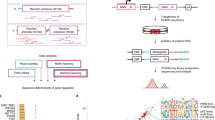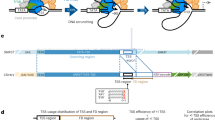Abstract
Understanding how precise control of gene expression is specified within regulatory DNA sequences is a key challenge with far-reaching implications. Many studies have focused on the regulatory role of transcription factor–binding sites. Here, we explore the transcriptional effects of different elements, nucleosome-disfavoring sequences and, specifically, poly(dA:dT) tracts that are highly prevalent in eukaryotic promoters. By measuring promoter activity for a large-scale promoter library, designed with systematic manipulations to the properties and spatial arrangement of poly(dA:dT) tracts, we show that these tracts significantly and causally affect transcription. We show that manipulating these elements offers a general genetic mechanism, applicable to promoters regulated by different transcription factors, for tuning expression in a predictable manner, with resolution that can be even finer than that attained by altering transcription factor sites. Overall, our results advance the understanding of the regulatory code and suggest a potential mechanism by which promoters yielding prespecified expression patterns can be designed.
This is a preview of subscription content, access via your institution
Access options
Subscribe to this journal
Receive 12 print issues and online access
$209.00 per year
only $17.42 per issue
Buy this article
- Purchase on Springer Link
- Instant access to full article PDF
Prices may be subject to local taxes which are calculated during checkout







Similar content being viewed by others
References
Ptashne, M. & Gann, A. Genes and Signals (Cold Spring Harbor Laboratory Press, Cold Spring Harbor, New York, 2002).
Kornberg, R.D. & Lorch, Y. Twenty-five years of the nucleosome, fundamental particle of the eukaryote chromosome. Cell 98, 285–294 (1999).
Polach, K.J. & Widom, J. Mechanism of protein access to specific DNA sequences in chromatin: a dynamic equilibrium model for gene regulation. J. Mol. Biol. 254, 130–149 (1995).
Kim, H.D. & O'Shea, E.K. A quantitative model of transcription factor–activated gene expression. Nat. Struct. Mol. Biol. 15, 1192–1198 (2008).
Lam, F.H., Steger, D.J. & O'Shea, E.K. Chromatin decouples promoter threshold from dynamic range. Nature 453, 246–250 (2008).
Liu, X., Lee, C.K., Granek, J.A., Clarke, N.D. & Lieb, J.D. Whole-genome comparison of Leu3 binding in vitro and in vivo reveals the importance of nucleosome occupancy in target site selection. Genome Res. 16, 1517–1528 (2006).
Raveh-Sadka, T., Levo, M. & Segal, E. Incorporating nucleosomes into thermodynamic models of transcription regulation. Genome Res. 19, 1480–1496 (2009).
Anderson, J.D. & Widom, J. Poly(dA-dT) promoter elements increase the equilibrium accessibility of nucleosomal DNA target sites. Mol. Cell. Biol. 21, 3830–3839 (2001).
Segal, E. & Widom, J. Poly(dA:dT) tracts: major determinants of nucleosome organization. Curr. Opin. Struct. Biol. 19, 65–71 (2009).
Kaplan, N. et al. The DNA-encoded nucleosome organization of a eukaryotic genome. Nature 458, 362–366 (2009).
Yuan, G.C. et al. Genome-scale identification of nucleosome positions in S. cerevisiae. Science 309, 626–630 (2005).
Zhang, Y. et al. Intrinsic histone-DNA interactions are not the major determinant of nucleosome positions in vivo. Nat. Struct. Mol. Biol. 16, 847–852 (2009).
Dechering, K.J., Cuelenaere, K., Konings, R.N. & Leunissen, J.A. Distinct frequency-distributions of homopolymeric DNA tracts in different genomes. Nucleic Acids Res. 26, 4056–4062 (1998).
Field, Y. et al. Distinct modes of regulation by chromatin encoded through nucleosome positioning signals. PLOS Comput. Biol. 4, e1000216 (2008).
Iyer, V. & Struhl, K. Poly(dA:dT), a ubiquitous promoter element that stimulates transcription via its intrinsic DNA structure. EMBO J. 14, 2570–2579 (1995).
Knutson, B.A. & Hahn, S. Domains of Tra1 important for activator recruitment and transcription coactivator functions of SAGA and NuA4 complexes. Mol. Cell. Biol. 31, 818–831 (2011).
Kuo, M.H., vom Baur, E., Struhl, K. & Allis, C.D. Gcn4 activator targets Gcn5 histone acetyltransferase to specific promoters independently of transcription. Mol. Cell 6, 1309–1320 (2000).
Zeevi, D. et al. Compensation for differences in gene copy number among yeast ribosomal proteins is encoded within their promoters. Genome Res. 21, 2114–2128 (2011).
Fordyce, P.M. et al. De novo identification and biophysical characterization of transcription-factor binding sites with microfluidic affinity analysis. Nat. Biotechnol. 28, 970–975 (2010).
Hill, D.E., Hope, I.A., Macke, J.P. & Struhl, K. Saturation mutagenesis of the yeast his3 regulatory site: requirements for transcriptional induction and for binding by GCN4 activator protein. Science 234, 451–457 (1986).
Zhu, C. et al. High-resolution DNA-binding specificity analysis of yeast transcription factors. Genome Res. 19, 556–566 (2009).
Yuan, G.C. & Liu, J.S. Genomic sequence is highly predictive of local nucleosome depletion. PLOS Comput. Biol. 4, e13 (2008).
Sekinger, E.A., Moqtaderi, Z. & Struhl, K. Intrinsic histone-DNA interactions and low nucleosome density are important for preferential accessibility of promoter regions in yeast. Mol. Cell 18, 735–748 (2005).
Miller, J.A. & Widom, J. Collaborative competition mechanism for gene activation in vivo. Mol. Cell. Biol. 23, 1623–1632 (2003).
Kornberg, R.D. & Stryer, L. Statistical distributions of nucleosomes: nonrandom locations by a stochastic mechanism. Nucleic Acids Res. 16, 6677–6690 (1988).
Beer, M.A. & Tavazoie, S. Predicting gene expression from sequence. Cell 117, 185–198 (2004).
Bintu, L. et al. Transcriptional regulation by the numbers: models. Curr. Opin. Genet. Dev. 15, 116–124 (2005).
Gertz, J., Siggia, E.D. & Cohen, B.A. Analysis of combinatorial cis-regulation in synthetic and genomic promoters. Nature 457, 215–218 (2009).
Segal, E., Raveh-Sadka, T., Schroeder, M., Unnerstall, U. & Gaul, U. Predicting expression patterns from regulatory sequence in Drosophila segmentation. Nature 451, 535–540 (2008).
Wasson, T. & Hartemink, A.J. An ensemble model of competitive multi-factor binding of the genome. Genome Res. 19, 2101–2112 (2009).
MacIsaac, K.D. et al. An improved map of conserved regulatory sites for Saccharomyces cerevisiae. BMC Bioinformatics 7, 113 (2006).
Zhu, C. et al. High-resolution DNA binding specificity analysis of yeast transcription factors. Genome Res. 19, 556–566 (2009).
Bar-Even, A. et al. Noise in protein expression scales with natural protein abundance. Nat. Genet. 38, 636–643 (2006).
Taniguchi, Y. et al. Quantifying E. coli proteome and transcriptome with single-molecule sensitivity in single cells. Science 329, 533–538 (2010).
Bai, L., Charvin, G., Siggia, E.D. & Cross, F.R. Nucleosome-depleted regions in cell-cycle-regulated promoters ensure reliable gene expression in every cell cycle. Dev. Cell 18, 544–555 (2010).
Raser, J.M. & O'Shea, E.K. Control of stochasticity in eukaryotic gene expression. Science 304, 1811–1814 (2004).
Cai, L., Friedman, N. & Xie, X.S. Stochastic protein expression in individual cells at the single molecule level. Nature 440, 358–362 (2006).
Friedman, N., Cai, L. & Xie, X.S. Linking stochastic dynamics to population distribution: an analytical framework of gene expression. Phys. Rev. Lett. 97, 168302 (2006).
Ercan, S., Lubling, Y., Segal, E. & Lieb, J.D. High nucleosome occupancy is encoded at X-linked gene promoters in C. elegans. Genome Res. 21, 237–244 (2011).
Chen, W. & Struhl, K. Saturation mutagenesis of a yeast his3 “TATA element”: genetic evidence for a specific TATA-binding protein. Proc. Natl. Acad. Sci. USA 85, 2691–2695 (1988).
Ben Yehezkel, T. et al. De novo DNA synthesis using single molecule PCR. Nucleic Acids Res. 36, e107 (2008).
Linshiz, G. et al. Recursive construction of perfect DNA molecules from imperfect oligonucleotides. Mol. Syst. Biol. 4, 191 (2008).
Shabi, U. et al. Processing DNA molecules as text. Syst. Synth. Biol. 4, 227–236 (2010).
Gietz, R.D. & Schiestl, R.H. Microtiter plate transformation using the LiAc/SS carrier DNA/PEG method. Nat. Protoc. 2, 5–8 (2007).
Acknowledgements
We wish to dedicate this paper to Jon Widom who inspired and assisted us greatly throughout this project. This work was supported by grants from the European Research Council (ERC) and the US National Institutes of Health (NIH) to E. Segal. E. Segal is the incumbent of the Soretta and Henry Shapiro career development chair. T.R.-S. and M.L. thank the Azrieli Foundation for the award of an Azrieli Fellowship. We thank G. Hornung for his help with the analysis of flow cytometry measurements and E. Mochly for his help with the preparation of Supplementary Figure 9.
Author information
Authors and Affiliations
Contributions
T.R.-S., M.L. and E. Segal conceived the project, designed promoter variants and analyzed the data. T.R.-S., M.L., A.W. and E. Segal planned all experiments. D.Z. and A.W. developed protocols for robotic strain assembly and activity measurements. D.Z., U.S. and M.L.-P. constructed the master strain. U.S. participated in the design of the variants, constructed the majority of variants and, together with M.L.-P., constructed strains. T.R.-S. and M.L. performed expression measurements. B.S. performed nucleosome occupancy measurements. L.K. participated in expression measurements and in their initial analysis. E. Sharon, together with T.R.-S., M.L. and L.K., developed the analysis pipeline. T.R.-S., M.L. and E. Segal wrote the manuscript. A.W. and E. Segal supervised and guided the research.
Corresponding authors
Ethics declarations
Competing interests
The authors declare no competing financial interests.
Supplementary information
Supplementary Text and Figures
Supplementary Figures 1–11, Supplementary Tables 1–5 and Supplementary Note (PDF 810 kb)
Rights and permissions
About this article
Cite this article
Raveh-Sadka, T., Levo, M., Shabi, U. et al. Manipulating nucleosome disfavoring sequences allows fine-tune regulation of gene expression in yeast. Nat Genet 44, 743–750 (2012). https://doi.org/10.1038/ng.2305
Received:
Accepted:
Published:
Issue Date:
DOI: https://doi.org/10.1038/ng.2305
This article is cited by
-
Micro and macroevolution of sea anemone venom phenotype
Nature Communications (2023)
-
Using Synthetic DNA Libraries to Investigate Chromatin and Gene Regulation
Chromosoma (2023)
-
oFlowSeq: a quantitative approach to identify protein coding mutations affecting cell type enrichment using mosaic CRISPR-Cas9 edited cerebral organoids
Human Genetics (2023)
-
High-throughput techniques enable advances in the roles of DNA and RNA secondary structures in transcriptional and post-transcriptional gene regulation
Genome Biology (2022)
-
Manipulating chromatin architecture in C. elegans
Epigenetics & Chromatin (2022)



